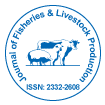Improving Disease Resistance in Tilapia: Genetic Solutions for a Sustainable Industry
Received: 01-Apr-2025 / Manuscript No. jflp-25-164725 / Editor assigned: 03-Apr-2025 / PreQC No. jflp-25-164725 / Reviewed: 17-Apr-2025 / QC No. jflp-25-164725 / Revised: 21-Apr-2025 / Manuscript No. jflp-25-164725 / Published Date: 28-Apr-2025 DOI: 10.4172/2332-2608.1000649
Keywords
Disease resistance; Tilapia aquaculture; Genetic improvement; Sustainable fish farming; Selective breeding
Introduction
Tilapia is one of the most widely farmed fish species globally, prized for its fast growth, adaptability, and economic value [1]. However, disease outbreaks continue to pose significant threats to the sustainability and profitability of tilapia farming, often leading to high mortality rates and economic losses. To address this challenge, genetic solutions are emerging as a promising approach to enhance disease resistance in tilapia [2]. Through techniques such as selective breeding, genomic selection, and biotechnology, researchers and aquaculture professionals aim to develop robust tilapia strains with improved immunity and resilience to pathogens [3]. By reducing the dependency on antibiotics and chemical treatments, these genetic advancements contribute to more sustainable and environmentally friendly fish farming practices. Improving disease resistance through genetics not only supports industry growth but also helps ensure food security and the long-term health of aquatic ecosystems [4].
Discussion
Enhancing disease resistance in tilapia through genetic approaches is increasingly recognized as a sustainable solution to one of aquaculture’s most pressing challenges [5]. Disease outbreaks, such as those caused by Streptococcus spp., Francisella spp., and Tilapia Lake Virus (TiLV), have led to substantial losses in tilapia production worldwide. Traditional disease management methods relying heavily on antibiotics and chemical treatments pose environmental risks and can contribute to the development of antimicrobial resistance [6]. As a result, genetic improvement has emerged as a forward-looking alternative that offers long-term resilience without compromising ecological integrity. Selective breeding programs, which have been successfully used in livestock and other aquaculture species, are being adapted for tilapia to enhance innate resistance to common pathogens [7]. These programs focus on identifying and propagating fish with naturally stronger immune responses, leading to cumulative improvements over generations [8]. Advances in molecular biology and genomics, such as marker-assisted selection and genomic selection, have significantly accelerated this process by enabling the identification of specific genes or markers associated with disease resistance [9].
Moreover, biotechnology tools like CRISPR and transgenesis, although still in the early stages of application for tilapia, show potential for precise genetic interventions that could confer resistance traits more effectively. However, ethical considerations, regulatory frameworks, and public perception continue to influence the pace at which such technologies are adopted. Importantly, integrating genetic solutions with good aquaculture practices—such as biosecurity, vaccination, and water quality management—can produce synergistic effects, further minimizing the risk of disease outbreaks. Overall, improving disease resistance in tilapia through genetic innovation not only enhances productivity and profitability but also supports the shift toward more sustainable and responsible aquaculture systems [10].
Conclusion
Genetic improvement for disease resistance in tilapia represents a critical advancement toward achieving sustainable and resilient aquaculture. By leveraging selective breeding, genomic tools, and emerging biotechnologies, the industry can reduce its reliance on antibiotics, lower production losses, and enhance fish health and welfare. These innovations offer a long-term, environmentally responsible strategy to combat persistent disease threats, ensuring stable yields and economic viability. As research progresses and genetic programs become more widely adopted, integrating these solutions with strong farm management practices will be essential to realizing the full potential of a healthier, more sustainable tilapia industry.
References
- Njenga SK (2005) Productivity and socio-cultural aspects of local poultry phenotypes in coastal Kenya. The Royal and Agricultural University (KVL), Denmark.
- FAO (2019) Poultry Sector Ethiopia. FAO Animal Production and Health Livestock Country Reviews.
- CSA (2017) The federal democratic republic of Ethiopia. Agricultural Sample Survey. Vol. II. Report on Livestock and Livestock Characteristics (Private Peasant Holdings), CSA, Addis Ababa, Ethiopia.
- Alam GMM, Khatun Most N, Kamruzzaman M (2012) Factors affecting poultry production: Empirical insights from areas of Bangladesh. Annals of Bangladesh Agriculture 16.
- Tadelle DS (2003) Phenotypic and genetic characterization of local chicken ecotypes in Ethiopia. PhD Dessertation, HumboldtUniversity, Berlin, Germany.
- Alemu Y, Tadele D (1997) The Status of Poultry Research and Development in Ethiopia, Research Bulletin No.4. Poultry Commodity Research Program Debre Zeit Agricultural Research Center. Alemaya University of Agriculture, Ethiopia 6.
- DAGRIS (2008) International Livestock Research Institute, Nairobi.
- Nebiyu Y, Brhan T, Kelay B (2013) Characterization of Village Chicken Production Performance under Scavenging System in Halaba District of Southern Ethiopia. Ethiop Vet J 17: 69-80.
- Dessie T, Taye (2011) Current state of knowledge on phenotypic characteristics of indigenous chickens in the tropics. World’s Poult Sci J 67: 507–516.
- Wondmeneh E, Van der Waaij EH, Dessie T, (2014) A running breeding program for indigenous chickens in Ethiopia: evaluation of success. American Society of Animal Science.
Citation: Roux A (2025) Improving Disease Resistance in Tilapia: Genetic Solutions for a Sustainable Industry. J Fisheries Livest Prod 13: 649. DOI: 10.4172/2332-2608.1000649
Copyright: © 2025 Roux A. This is an open-access article distributed under the terms of the Creative Commons Attribution License, which permits unrestricted use, distribution, and reproduction in any medium, provided the original author and source are credited.
Select your language of interest to view the total content in your interested language
Share This Article
Recommended Journals
Open Access Journals
Article Tools
Article Usage
- Total views: 892
- [From(publication date): 0-0 - Dec 09, 2025]
- Breakdown by view type
- HTML page views: 751
- PDF downloads: 141
